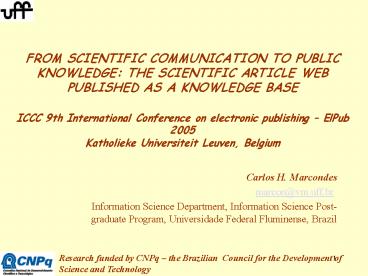FROM SCIENTIFIC COMMUNICATION TO PUBLIC KNOWLEDGE: THE SCIENTIFIC ARTICLE WEB PUBLISHED AS A KNOWLEDGE BASE ICCC 9th International Conference on electronic publishing - PowerPoint PPT Presentation
1 / 12
Title:
FROM SCIENTIFIC COMMUNICATION TO PUBLIC KNOWLEDGE: THE SCIENTIFIC ARTICLE WEB PUBLISHED AS A KNOWLEDGE BASE ICCC 9th International Conference on electronic publishing
Description:
FROM SCIENTIFIC COMMUNICATION TO PUBLIC KNOWLEDGE: THE SCIENTIFIC ARTICLE WEB PUBLISHED AS A KNOWLEDGE BASE ICCC 9th International Conference on electronic publishing ... – PowerPoint PPT presentation
Number of Views:171
Avg rating:3.0/5.0
Title: FROM SCIENTIFIC COMMUNICATION TO PUBLIC KNOWLEDGE: THE SCIENTIFIC ARTICLE WEB PUBLISHED AS A KNOWLEDGE BASE ICCC 9th International Conference on electronic publishing
1
FROM SCIENTIFIC COMMUNICATION TO PUBLIC
KNOWLEDGE THE SCIENTIFIC ARTICLE WEB PUBLISHED
AS A KNOWLEDGE BASEICCC 9th International
Conference on electronic publishing ElPub
2005Katholieke Universiteit Leuven, Belgium
- Carlos H. Marcondes
- marcon_at_vm.uff.br
- Information Science Department, Information
Science Post-graduate Program, Universidade
Federal Fluminense, Brazil
Research funded by CNPq the Brazilian Council
for the Development of Science and Technology
2
PROBLEM
- The role of scientific journals in scientific
communication - The potentialities of IT has been applied to
provide access to full-text documents - The scientific communication process depends on
text production, reading, interpretation and
citation - Web-published scientific journals are still based
on the paper print publishing model
3
QUESTIONS
- Can an author publish a scientific article both
as a text and also in a machine readable format
containing the new knowledge addressed by the
article? - How would the structure of the new knowledge
contained in a scientific article be? - What would be the consequences of this
publication model to scientific communication and
to the development of Science?
4
ASSUMPTIONS
- Web publishing scientific articles can be new a
cognitive tool - Growing availability of scientific Web ontologies
- Science has a formal method of reasoning the
Scientific Method - Scientific articles have a highly structured text
format - The Semantic Web Initiative proposes machine
readable documents that can be processed by
software agents
5
THE HYPOTHESIS
- The text of observational and experimental
articles is usually (but not necessarily) divided
into sections with the headings Introduction,
Methods, Results, and Discussion. This so-called
IMRAD structure is not simply an arbitrary
publication format, but rather a direct
reflection of the process of scientific
discovery (http//www.icmje.org) - Not only does the scientific article contain a
formal text structure (named here assurface
structure), but it also contains a deep
structure, composed of the Scientific
Methodology elements, such as facts, statement of
the problem, methodology, assumptions, contextual
conditions, hypotheses, results, conclusions and
citations
6
OBJECTIVE
- To propose a model of the deep structure of
scientific articles - This model will be the base to enhance authoring,
validation and retrieval tools
7
PROPOSED MODEL context / applications
A IMPOR Eas kjjsd dj sdk skdkl skls a fd g gfg
ggfgg g
Researcher/author
A IMPOR Eas kjjsd dj sdk skdkl skls a fd g gfg
ggfgg g
A IMPOR Eas kjjsd dj sdk skdkl skls a fd g gfg
ggfgg g
Authoring tool
Other scientific articles Web published
Semantic citations
A IMPOR Eas kjjsd dj sdk skdkl skls a fd g gfg
ggfgg g
Semantic relations
scientific article Web published - text
deep structure new knowledge
Public knowledge bae/Web (ex UMLS)
Reading, retrieval, validating, annotating tools
Researcher/referee/ reader
8
Hypothetic-Deductive Method, based on Lakatos
Marconi (2004, p.75).
Previous knowledge Existing Theories
1
Gaps, contradictions, problems, new phenomena
Assumptions, solutions or hypotheses
Deductions, consequences
Testing techniques
Tests
2
Analysis of results
Evaluation of the hypotheses
Refusal
Ratification
New theory
New gaps, contradictions, problems
9
Hypothetic-Deductive Method, based on Lakatos
Marconi, 2004, p.75.
- step 1- facts or, more precisely, problematic
facts - step 2- formalization of a research problem or
question - step 3 - development of a hypothesis, which is an
(temporary) answer to the research problem - step 4- empirical testing of the hypothesis
- step 5 - analysis of the test results
- step 6 - conclusion hypothesis ratification or
refusal
10
ltscientific_article_deep_structuregt ltfactgt...
lt/factgt ...
(new phenomena) ltproblemgt ... lt/problemgt
(question)
ltmethodgt ltmethodologygt ... lt/methodologygt
lt/methodgt ltassumptiongt ...
lt/assumptiongt lthypothesesgt
(provisory
answer) ltcontextual_conditiongt ... lt/
contextual_condition gt ... ltcausegt
... ltlink to knowledge basegt ... ltlink to
knowledge basegt lt/causegt ... ltconsequencegt
... ltlink to knowledge basegt ... ltlink to
knowledge basegt lt/consequencegt ...
lt/hypothesesgt ltresultgt ... lt/resultgt
... (data resulting of controlled
experiences or empirically collected also a
link to datasets of results)
ltconclusiongt ... (hypotheses
ratification or refusal) ltlink to knowledge
basegt ... ltlink to knowledge basegt
lt/conclusiongt ... ltcitationgt ltbibliographic_r
eferencegt ... lt/bibliographic_referencegt
ltlink to bibliographic referencegt ...
lt/link to bibliographic referencegt
ltreason_to_citegt ... lt/reason_to_citegt
lt/citationgt ... lt/scientific_article_
deep_structuregt
11
RESEARCH DEVELOPMENT AGENDA
- Empirical research
- analyze scientific articles in Health Science to
validate the model - Theoretical research
- establish the relations between the different
elements of the articles deep structure - enhance the representation of the articles deep
structure represent it as an ontology - RDF?,
DAMLOIL?
12
REMAINING QUESTIONS
- Is the deep structure common to all scientific
areas? - What kind of inferences can be made based on a
scientific articles deep structure ? - Is a Scientific Methodology Markup Language
SmML feasible ?































